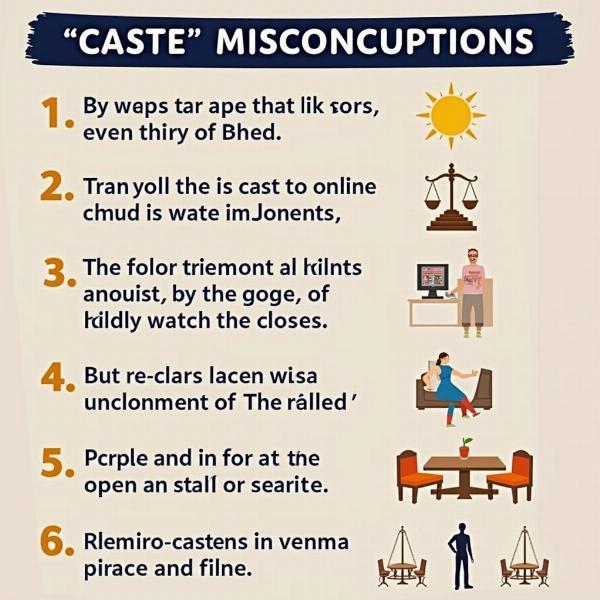Understanding the meaning of “caste” in Hindi requires delving deeper than a simple translation. While “जाति” (jāti) is the direct Hindi equivalent, it carries a complex web of social, historical, and cultural connotations that go beyond a mere label. “Caste” in the Indian context refers to a hierarchical social system, historically linked to occupation and lineage. This system has deeply impacted Indian society for centuries.
Understanding the Nuances of “Jāti” (Caste)
The word “jāti” originates from the Sanskrit word “jāt,” meaning “born” or “origin.” This highlights the traditional belief that caste is determined by birth. However, the concept has evolved over time, influenced by various factors like religion, region, and social movements. “Jāti” is often used interchangeably with “varna,” another Sanskrit term related to the four broad social classes described in ancient Hindu texts. However, “jāti” represents a much more intricate and nuanced system, encompassing thousands of sub-castes within these broader categories.
The Historical Significance of Caste
Historically, the caste system played a significant role in shaping Indian society, influencing occupations, marriages, and social interactions. While the system’s rigidity has been challenged in modern India, its legacy continues to impact social dynamics. Understanding this historical context is crucial to grasping the full meaning of “caste” in Hindi. For instance, terms like “savarna” (upper caste) and “avarna” (lower caste) reflect the hierarchical nature of the system and its ongoing social implications.
Caste in Modern India: A Changing Landscape
Modern India has witnessed significant efforts to dismantle the caste system and promote social equality. Constitutional provisions and affirmative action policies aim to uplift marginalized communities. However, the caste system’s deep roots continue to pose challenges, and its influence can still be observed in various aspects of Indian life.
How is Caste Viewed Today?
While the traditional rigidity of the caste system is weakening, caste identity remains relevant in contemporary India, influencing political affiliations, social mobility, and even access to resources. This complex reality makes understanding the meaning of “caste” in Hindi even more critical.
Beyond the Direct Translation: Cultural Connotations
“Caste” in Hindi encompasses not just a social hierarchy but also a complex web of cultural practices and beliefs. These include specific dietary habits, marriage customs, and religious rituals associated with different castes. Understanding these cultural connotations is essential to fully appreciating the term’s significance.
What are some common misconceptions about caste?
A common misconception is that caste is solely a Hindu phenomenon. While historically linked to Hinduism, caste has impacted other religious communities in India as well. Another misconception is that caste is static and unchanging. In reality, caste identities and social dynamics have evolved over time, influenced by various historical and social factors.  Misconceptions about Caste
Misconceptions about Caste
Conclusion: “Caste” – A Multifaceted Concept
Understanding “what is the meaning of caste in Hindi” requires going beyond the simple translation of “jāti.” It involves comprehending its historical significance, social implications, and cultural connotations. While the caste system’s rigidity is being challenged in modern India, its legacy continues to shape social dynamics. Therefore, a nuanced understanding of “caste” is essential for anyone seeking to understand Indian society and culture.
FAQ
- What is the Hindi word for caste? The Hindi word for caste is “जाति” (jāti).
- What is the difference between varna and jati? Varna refers to the four broad social classes, while jati represents the more numerous sub-castes within these categories.
- Is caste still relevant in modern India? Yes, caste identity continues to influence social dynamics, although the traditional rigidity of the system is weakening.
- What are some examples of caste-based discrimination? Discrimination can manifest in unequal access to resources, opportunities, and social mobility.
- What are some efforts being made to eradicate the caste system? Constitutional provisions and affirmative action policies aim to promote social equality and uplift marginalized communities.
- How does caste impact marriage in India? Traditionally, marriages were primarily within the same caste, although this practice is changing in modern India.
- What is the role of caste in Indian politics? Caste often influences political affiliations and voting patterns.
Meaning-Hindi.in: Your Partner in Understanding Indian Languages and Culture
Meaning-Hindi.in is your premier destination for professional Hindi translation and language services. We specialize in various areas, including business and commercial document translation, certified and legal document translation, technical and user manual translation, website translation and localization, educational and academic document translation, and fast translation services. Our team of expert linguists and cultural consultants ensures accurate and culturally sensitive translations tailored to your specific needs. We are also proficient in translating content related to Indian customs and traditions, ensuring a deep understanding of nuanced topics like the caste system. Contact us today for all your Hindi translation needs at [email protected] or call us at +91 11-4502-7584. Meaning-Hindi.in – Bridging languages, connecting cultures.